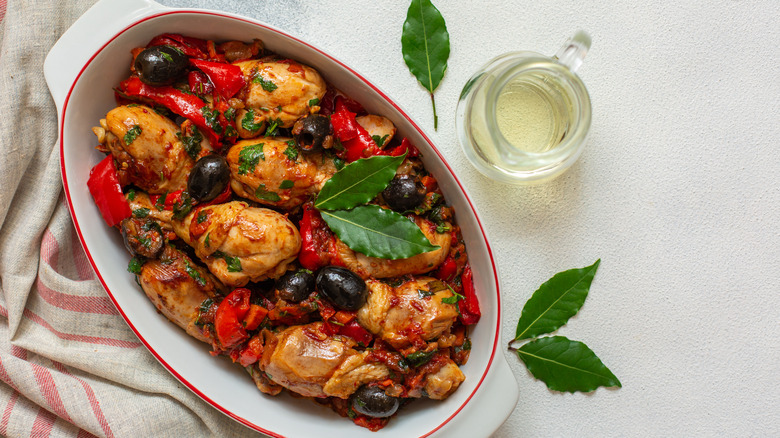The Flavors To Expect When You See 'Cacciatore' On A Menu
Italian is a beautiful language. Spoken with passion, in a cadence that is almost poetic, words roll off the tongue like a love song. It's part of what makes eating out at an Italian restaurant fun; you get to order things like pasta all'amatriciana, carbonara, and bolognese in your best Italian accent. Classic Italian dishes take their names from various sources. Sometimes, a dish is named after its place of origin (like "bolognese" which hails from Bologna), and others denote people (as in "carbonara," which means coal miner's wife). Still, others simply announce what is in the dish itself, such as chicken Marsala which utilizes Marsala wine.
A favorite preparation in Italian homes and restaurants is the savory cacciatore, which typically comes with chicken, although it can accompany any kind of meat. Those who enjoy cacciatore are probably accustomed to a stew-like dish that is made with tomato, onions, herbs, wine, and sometimes bell peppers. But, in reality, a dish prepared "cacciatore-style" doesn't necessarily have to include all of these ingredients.
What exactly is cacciatore?
Cacciatore comes from the Italian word for "hunter," which suggests its origin. Interestingly enough, in Italy, the popular chicken dish is called pollo alla cacciatora which is feminine, meaning "huntress." It can be deduced that early Italian hunters would sometimes spend days in the wild in search of game. And in their quest to put food on the tables of their homes or communities, they had to eat themselves and probably utilized small game like rabbit and pheasant. To flavor their food and to add extra nutrition, they would have used wild ingredients they picked up along the way, like garlic and herbs like rosemary.
So, when you see something described as "cacciatore," it's safe to assume that these two ingredients are present, along with whatever is locally plentiful, which the Italians are known for. For example, in southern Italy, chicken cacciatore is often made with local red wine, while it's made with local white wine in cooler northern Italy. As mentioned, you'll nearly always see it prepared with tomatoes and, many times, with mushrooms or olives. It's a wonderfully comforting style of cooking that warms the belly and the soul. Plus, it's fun to say.

